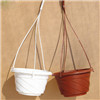Introduction: Selecting the right plant pot size is a critical aspect of successful gardening. The size of the pot directly impacts the health and growth of your plants. In this blog, we guide you through the process of choosing the perfect plant pot sizes based on the type of plants, their growth requirements, and the available space in your garden or home.
- Consider Plant Type and Size: Different plants have varying root systems and growth habits. For small plants, such as herbs or succulents, choose pots with a diameter of 4-6 inches. Medium-sized plants, like most indoor houseplants, thrive in pots with a diameter of 6-10 inches. Large plants, such as mature shrubs or small trees, require pots with a diameter of 14-20 inches or more.
- Room for Growth: When choosing a plant pot, consider the growth potential of your plant. Opt for pots that allow ample room for the plant’s roots to spread and establish. Overcrowded roots can lead to stunted growth and unhealthy plants. As a general rule, the diameter of the pot should be at least 2 inches wider than the current size of the plant’s root ball.
- Balance between Watering and Drainage: The size of the pot affects how much water the soil retains and how quickly it drains. Larger pots retain moisture for a longer time, which is beneficial for plants that prefer consistently moist soil. Smaller pots, on the other hand, dry out more quickly, making them suitable for plants that prefer drier soil conditions.
- Indoor and Outdoor Considerations: Indoor plants often require smaller pots due to space limitations. Choose pots that complement your interior décor while allowing sufficient room for the plant’s growth. For outdoor gardening, consider larger pots to accommodate the growth of perennial plants or to create eye-catching focal points with seasonal displays.
- Repotting and Plant Health: As plants grow, they may outgrow their pots. Regularly check the plant’s root system, and if it appears root-bound or overcrowded, consider repotting into a larger container. Repotting allows the plant to access fresh nutrients and promotes healthy growth.
- Container Material: The material of the plant pot can also impact plant health. For example, clay pots tend to dry out more quickly, while plastic pots retain moisture for longer periods. Consider the material’s impact on water retention and drainage when selecting the pot size.
Conclusion: Choosing the right plant pot size is an essential factor in maintaining healthy and thriving plants. By considering the plant type, growth requirements, and available space, you can ensure your plants have ample room to grow and flourish. With proper pot sizing, you’ll create an ideal environment for your plants to thrive and add beauty to your indoor or outdoor space.


















